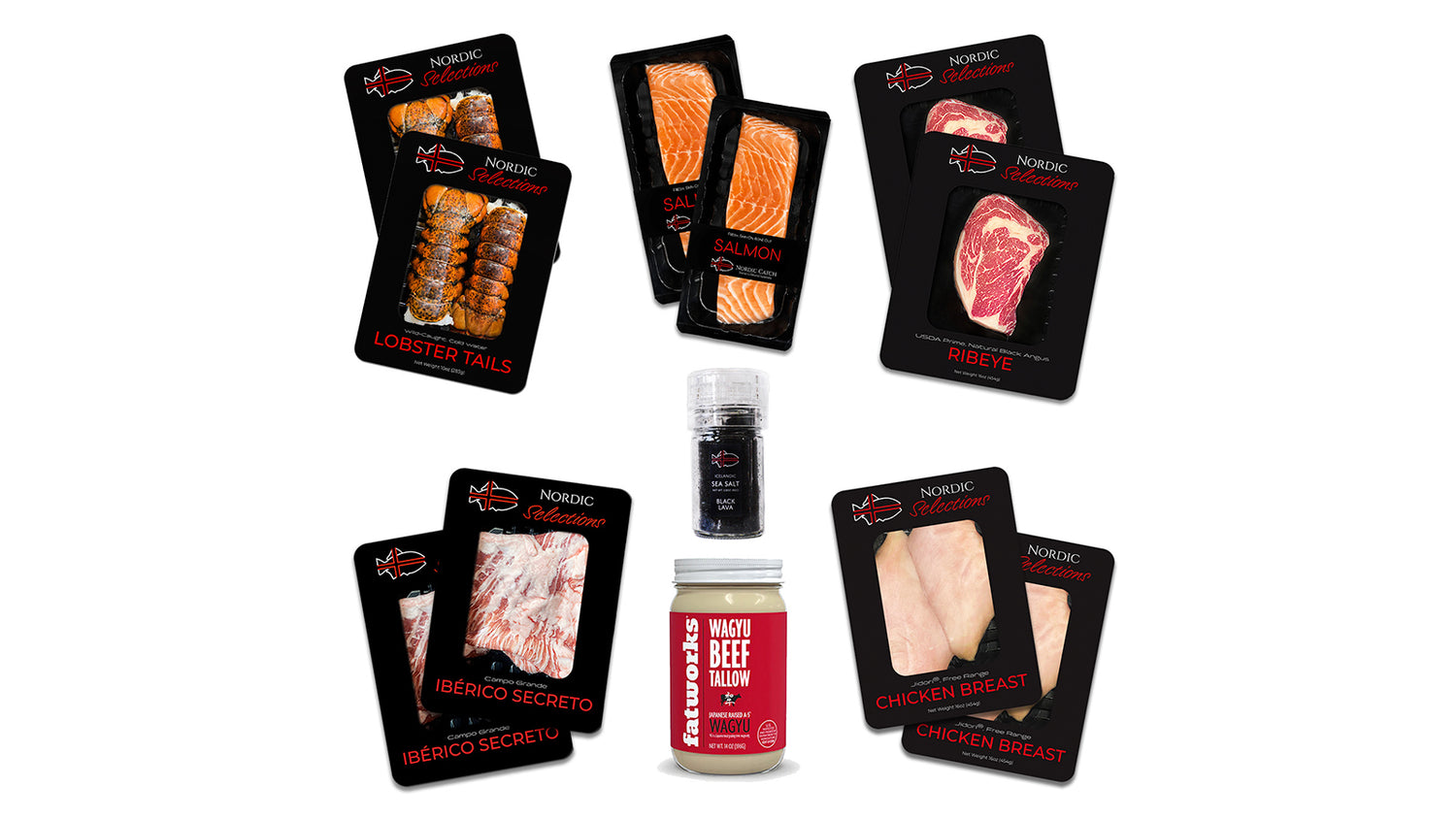
7 Best Health Benefits of Seafood
Over 3 billion people around the globe consume seafood daily as part of their protein intake — that's 3 billion people who are potentially taking advantage of some of the incredible health benefits of seafood. And now, thanks to fresh seafood delivery services, it's never been easier to enjoy these benefits yourself.
In addition to being a great source of protein, seafood is packed with essential vitamins, nutrients, and omega-3 fatty acids — all of which are important for a well-balanced diet. Let's explore the potential benefits more.
Nutritional Profile of Seafood
Wild-caught seafood is loaded with high-quality proteins, essential vitamins, and minerals. You've likely heard that it's a great source of omega-3 fatty acids, like eicosapentaenoic acid (EPA) and docosahexaenoic acid (DHA), which are crucial for brain and heart health. These compounds are in fish pills, a common dietary supplement.
Some seafood species have more omega-3 than others, namely fresh sushi-grade salmon, trout, and oysters. The human body cannot naturally produce omega-3s alone, so regularly eating these fish is critical to your body's health.
Omega-3 is essential in lowering blood pressure and cholesterol, reducing joint inflammation, and supporting brain and eye function. Scientists have even linked omega-3s to the prevention and management of chronic conditions such as dementia, depression, asthma, migraine, and diabetes.
Most fish and seafood species are vital protein sources, arguably the most essential macronutrient in muscle growth and weight loss. Seafood's low-calorie, high-protein content, particularly in shellfish like clams, makes it a fantastic choice for a healthy diet.
The American Heart Association recommends eating two servings of fatty fish twice weekly. Shellfish like clams offer a high protein-to-fat ratio and low-calorie count, making them great for muscle gain, weight loss, and weight management. Shrimp, one of the most popular kinds of seafood in the US, also offers a high protein-to-fat ratio and low-calorie count.
These are just a few health benefits that seafood can provide as part of a healthy, well-balanced diet. Let's explore the specific benefits of eating seafood regularly.
7 Health Benefits of Seafood
Strengthens heart health to protect against heart disease
The omega-3 fatty acids and proteins in seafood significantly improve heart health by reducing the risk of heart disease. Studies show that people who eat seafood, particularly fatty fish like certain species of salmon, sardines, trout, and mackerel, have a 15% lower risk of heart disease. Omega-3s reduce blood pressure, improve cholesterol levels, and support cardiovascular health.
Seafood's potassium content helps regulate blood pressure, while unsaturated fats improve cholesterol levels. Omega-3-rich fish boosts HDL (good cholesterol) and reduces triglycerides, further protecting the heart from degeneration and heart disease, the leading cause of death in the United States.
Supports brain health to lower the risk of cognitive decline and Alzheimer's
The omega-3s found in fish like salmon and trout also support cognitive functions, memory, and neuron health. Regular consumption of seafood helps maintain brain connections, enhancing memory and learning. Studies also show that omega-3s lower the risk of Alzheimer's and other neurodegenerative diseases.
Seafood has even been linked to a slew of mental health benefits, specifically reducing the risk of depression and helping manage anxiety. How? Those same potent omega-3s positively impact mood and stress management, helping regulate emotions and reduce the effects of stressors.
Omega-3s are a superfood, and fatty fish are the best source on the planet. They are more concentrated than nuts, seeds, oils, or leafy vegetables.
Improves joint health and reduces inflammatory bone & joint pain
In addition to supporting the two most important organs in your body, the heart and brain, regular consumption of omega-3-rich fish like salmon and mackerel can help improve joint health and reduce inflammation. Specifically, a seafood diet can help relieve arthritis symptoms such as pain, stiffness, and inflammation and slow the body's natural aging process, keeping your joints younger for longer.
Those same anti-inflammatory properties also reduce inflammation in vital organs, reducing the production of eicosanoids and cytokines, two molecules and substances linked to inflammation.
Strengthens immune system to fight off disease & infection
Zinc is another essential mineral abundant in certain seafood species, such as oysters, crabs, shrimp, and mussels. These are all well known for their ability to enhance immune function, assist the body in warding off diseases and infections, and heal wounds.
Fish also contains antioxidants like astaxanthin, which reduce inflammation and protect cells from oxidative stress. Oxidative stress breaks down cell tissue and damages DNA. Consistent levels of oxidative stress are one of the leading causes of deadly diseases like diabetes and cancer, as well as premature aging processes.
Regularly eating seafood can protect your body from this stress, enhancing your health and lifespan—two benefits even modern medicine cannot yet provide.
Improves skin, hair, and bone health
Omega-3s improve skin elasticity, reduce acne and irritation, and promote a healthy glow. Zinc also reduces inflammation and calms skin and scalp conditions like eczema and psoriasis.
The high protein content in seafood strengthens hair, reducing breakage and promoting growth. Finally, vitamin D aids calcium absorption and boosts bone health, increasing bone density and preventing osteoporosis and other degenerative bone conditions.
Supports pregnancy and infant health
Seafood is vital for fetal development, particularly during pregnancy. Omega-3 fatty acids support brain and eye development in fetuses. At the same time, vitamins B6 and B12 contribute to red blood cell formation and reduce the risk of congenital disabilities. Research shows that higher maternal fish consumption during pregnancy improves infant cognitive outcomes.
Additionally, seafood's protein content helps reduce the risk of preterm birth. Pregnant women who eat seafood rich in omega-3s can provide critical nutrients for their babies' development while improving their health.
However, medical experts advise against eating raw or undercooked seafood while pregnant. It may contain bacteria and parasites that can cause infections and foodborne illnesses, which are detrimental to the mother and the fetus.
Seafood can help you lose weight and gain muscle.
Pound for pound, seafood is one of the best sources of animal protein on the planet. If you want to lose weight or gain muscle, seafood can help you. Foods high in protein reduce satiety, meaning you'll feel fuller despite eating fewer calories. The proteins in seafood also require more energy to digest, so compared to carbohydrates or sugar, your body burns more calories digesting the seafood.
Of course, protein is the building block of muscles. A higher-protein diet will yield more remarkable muscle growth over time when combined with regular exercise and weight training.
Below is an overview of some popular seafood's calorie-to-protein ratio compared to other animal proteins.
Protein Comparison of Widely Consumed Seafoods
|
Fish Type |
Calories |
Protein (g) |
|
Tuna (Yellowfin) |
139 |
30.0 |
|
Cod |
105 |
22.8 |
|
Halibut |
122 |
20.6 |
|
Tilapia |
128 |
26.3 |
|
Salmon |
206 |
22.1 |
|
Shrimp |
99 |
20.9 |
Protein Comparison of Widely Consumed Animal Proteins
|
Protein Source |
Calories |
Protein (g) |
|
Chicken breast |
165 |
31.0 |
|
Steak |
271 |
26.0 |
|
Bacon |
541 |
37.0 |
|
Sausage |
301 |
16.0 |
|
Ground beef |
250 |
26.0 |
|
Ground turkey |
203 |
23.0 |
On average, seafood's calorie-to-protein ratio is higher than other popular animal protein sources. When you factor in the difference between wild-caught and farm-raised seafood, especially compared to the chemicals many chickens, cows, and pigs are raised with, deciding which to consume more often becomes more manageable.
Potential Risks and Considerations of Eating Seafood
While seafood offers numerous benefits, it's essential to be aware of the potential risks, such as ingesting mercury and other pollutants. Mercury can accumulate in fish and pose health risks, mainly to brain function. However, you can mitigate these risks by choosing seafood species that are less likely to contain pollutants, polychlorinated biphenyls (PCBs), and microplastics — specifically fresh and sustainably sourced seafood.
Overfishing and unsustainable practices can harm ocean ecosystems. When buying seafood, look for third-party certifications like the Marine Stewardship Council (MSC) to ensure you make environmentally friendly choices.
Lastly, ensure proper handling and cooking of seafood to avoid foodborne illnesses. Raw or undercooked seafood can carry harmful pathogens, so proper storage and cooking techniques are necessary. If you're new to cooking seafood, check out our guide on safely thawing seafood for optimal taste.
How to Incorporate Seafood into Your Diet
If you want to start eating more seafood, here are our tips for building a healthy habit.
- Plan to eat seafood weekly: Eat seafood at least twice a week. Include a variety of healthy fish and shellfish to get a broad range of nutrients.
- Try other cooking methods: Bake, grill, or steam seafood instead of frying it to retain health benefits and minimize added fats.
- Get creative: Add seafood to your salads, pasta, or stir-fries for a nutritious boost. While fresh seafood is best, you can use canned fish like tuna or sardines in a pinch in sandwiches or wraps.
- Pay attention to what's in season: Check local seafood guides for information on what's in season and sustainable for the best flavor and peace of mind.
- Choose healthy sides: Pair seafood with vegetables and whole grains for balanced meals. For instance, you can serve grilled salmon with quinoa and steamed broccoli.
Frequently Asked Questions
What are the health benefits of seafood for pregnancy and infant health?
Consumption of seafood during pregnancy is a powerful way to provide essential nutrients like omega-3 fatty acids, protein, and minerals that support fetal brain development, improve infant cognitive outcomes, and may reduce the risk of preterm birth and low birth weight.
Are there any risks associated with seafood consumption?
While seafood is a valuable source of nutrients, it's essential to be aware of potential health risks. Contaminants like mercury, PCBs, and microplastics can be present, posing a risk, especially for vulnerable groups such as pregnant women, children, and those who consume large quantities of fish.
How can we ensure our seafood choices are sustainable?
Look for certifications like the Marine Stewardship Council (MSC) and Aquaculture Stewardship Council (ASC), which indicate the seafood has been sourced using eco-friendly means and is sustainable.
What precautions should you take to ensure the safety of your seafood?
Store your seafood correctly to prevent cross-contamination. Cook the seafood at the right temperature to kill pathogens and enjoy its full health benefits.

